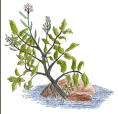|
Watercress
Evolution, Genetics
|

|
Evolution |
Angiosperms originated in the tropics in the Cretaceous period. Probably in West Gondwanna land (S.America and Africa) it then spread North to Laurasia land. They are adaptations of the early fern like vascular plants. The flower was probably innovated by seasonal change were periods of reproduction were restricted by drought. Insect pollinator abundance played an important part in the timing of flower bloom. |
Cultivars |
(Rorripa) Nasturtium microphylla (Boeen)Hyl
As N.officionale but stems and leaves turn brown/purple in autumn. Fruit and stalk slightly longer and more slender approx. 100 polygonal depressions in each face of seed coat. Flowers 2 weeks later than N.officinale. Not cultivated. Distinguishable vegitatively by its ration of stomata to total number of epidermal initials. Lower epidermis 11 % N.microphyllum. 18% for N.officionale. It is probably a allotetraploid, deriving from a cross
between N.officionale and a Cardamine species
|
Genetic Hybrid Progression - Future |
An autotetraploid (polyploid) has been derived from one diploid species (cross species hybrid) by multiplication of its chromosome sets by colchine (drug that reacts reversibly with protein tublin which renders sterile hybrid fertile) and a tetraploid hybrid by crossing N.officionale with N.microphyllum; both will become important for commercial production. |
Collated by James M. Burton as part of H.N.D. course at Pencoed
Agricultural College. Taxanomical information correct as of 06:06:97.